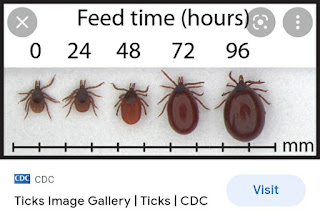It's that time of year again... time to hopefully bombard everyone with facts about Lyme Disease - awareness, prevention, & treatments (or lack of them) as well as tick awareness.
Please share my blog posts or social media posts so people have access to this vital information.
I started this blog in 2011, and it has been a long and very twisty journey for me, with SO many things impacting my health; however when it comes to Lyme Disease in the UK, we have not advanced very much, in practical terms, for people who are ill and need treatment.
Prevention is ALWAYS better than cure, and in the case of Lyme, that is 100% true. Lyme can be cured if it is treated immediately following a tick bite, with the correct dose of antibiotics, but once borrelia spirochetes (the type of bacteria that causes Lyme Disease) begin to spread throughout the body, treatment becomes increasingly more difficult. Lyme Disease experts do not speak about curing systemic/ chronic Lyme, but about it going into remission.
The bacteria can remain in the body in a dormant state, and become active again following any kind of trauma/ illness to the body. I personally experienced this in 2016 (resulting in treatment in 2017, 2018 & 2019) after I had a car accident at the end of 2015.
The information below is SO important.
ALWAYS tick check after you've been outside - even in your own garden.
Contrary to some 'opinions', ticks are everywhere in the UK (& in every state in the US, & have been found on every continent, including Antarctica).
Removing a tick quickly reduces the risk of the tick spreading infections. However it is NOT necessary for a tick to be attached for a specified period of time before it can transmit infectious organisms.
Lyme Disease, caused by borrelia burgdorferi spirochetes is often accompanied by other co-infections such as babesia, erlichia, bartonella, & others. All are difficult to detect and difficult to treat.
Ticks deserve their nickname: nature's dirty needle.
Knowing how to remove a tick properly is essential - details below:
Right at the beginning of May, as if on cue, my brother-in-law found this (well fed 🤢) tick on one of their cats.
🕷 He removed it properly, with a @ticktwister.co.uk - you can see the head is fully intact.
To remove a tick from a person or pet, grip the mouthparts, as close to the skin as possible & pull straight upwards, with fine-nosed tweezers or a specialised tick removal tool. Do not irritate the tick (e.g. with ointment/ flames) as this can cause it to regurgitate dangerous bacteria into the bloodstream.
Do not twist it yourself as this can cause the mouthpart to break off and remain in the skin (if using the 'tick twister' tool, it removes it effectively; carefully follow instructions on any tool you have - & add one to your first aid kit, they make removal MUCH easier).
🕷 To safely dispose of a removed tick, DO NOT BURST. Sticky tape is a good option - as shown here. Carefully ensure the tape is firmly stuck all around the tick for disposal, or to send for testing.
(This is now in a sealed sandwich bag, ready to be sent away. Sometimes local vets will accept ticks to send for testing. You can search online where to send it in your area.)
🕷 The lighter part of the tick shows it has fed (it's swollen with blood). If this bursts, there is a small risk of infection if any splatter gets into an open wound, or, e.g. hits your eye. Be careful.
The size of the tick can indicate roughly how long it was attached:
(Image from CDC website, via Google)
🕷 Wash your hands thoroughly afterwards.
🕷 Make sure your pets are flea & tick treated; but continue to check them - tick treatment is not a repellent, it slowly kills ticks as they feed. Be aware, if ticks drop off alive, they may then feed on humans.
🕷 So... TICK CHECK! Always!
Ticks like to crawl into safe, warm crevices in the body - check EVERYWHERE.
Check kids at bathtime, & teach them how to check themselves too.
(Be aware of any tiny freckles you have - I have one on the back of my leg that has given me a fright several times in the past!! Using your hands as well as your eyes while you check will ensure you feel an embedded tick.)
🕷 Wear repellent outdoors (Autan is best in the UK) & always tick check carefully when you get home.
🕷 Remember - ticks are tiny. They also like to crawl into crevices in the body where they can hide, like under the arm or in the groin - check EVERYWHERE!
(Image also from US CDC website)


















